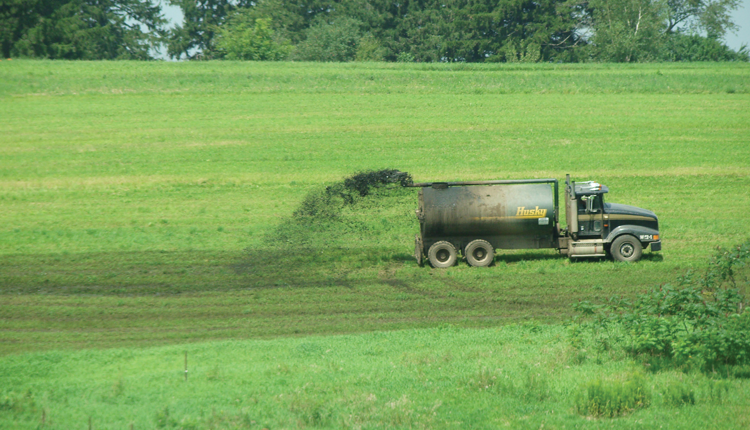
When choosing which management practices best fit into a system, Step 1 is to prioritize those that keep the soil covered as much as possible throughout the year to prevent soil erosion, reduce phosphorus loss, and improve soil health (Figure 1). Practices like no-till, high residue cover, and cover crops have shown reductions in soil erosion and particulate phosphorus loss at Discovery Farms sites.
Next, think about the added nutrient source (fertilizer or manure) rate and timing. For Step 2, determine your phosphorus rate based on recommendations that take into account plant uptake and previous soil fertility. If nutrients added are greater than the recommendation, phosphorus is vulnerable to loss through surface runoff. This is even more critical if the nutrients are added when the risk for runoff is highest during late winter and early spring.
Keep it covered
Once you have those two pieces in place, Step 3 is adding an overwintering cover crop to the rotation. Cover crops are a great tool to help cover and protect the soil, especially during months when a field is typically bare. Cover crops also impact nutrient levels by recycling nutrients back to the soil surface, which impacts Step 2. However, studies have shown that cover crops and crop residues can create a significant supply of phosphorus on the soil surface that could be of concern during the nongrowing season. In cold climates, the repeated freeze and thaw cycles convert the phosphorus to a readily-available form, which creates a concern for water quality. If a cover crop dies during the winter, it will not be as successful at protecting the soil or relaying nutrients to the next crop. A live, green cover crop is a better option for a longer window of soil protection and holding nutrients into the next growing season.
Dead or alive?
Because he was intrigued by research showing dissolved phosphorus in winter runoff in Wisconsin cropping systems, Steve Hoffman, agronomist and president of InDepth Agronomy in eastern Wisconsin, began an investigation into potential phosphorus contributions from overwintering or winterkilled cover crops. Hoffman found that water surrounding dead leaf tissues has a higher concentration of phosphorus compared to water by tissues that are still alive.
He tested this idea by placing a naturally senesced corn leaf and a live leaf in distilled water for three hours. Using a Hanna HI 706 P HR checker HC to compare the phosphorus levels, he found that the water with the dead leaf contained 15 ppm dissolved phosphorus (DP) versus 0.5 ppm DP from the live leaf sample (Figure 2).
Interested to learn more, Hoffman honed in on cover crops and compared several other live versus dead species (peas, oats, radish, and more). He found that in every case, the dead crop released much higher phosphorus concentrations than the live ones. This idea is supported by a study in Indiana that found in a system with an overwintering cereal rye cover crop, dissolved phosphorus levels were significantly lower compared to a winterkilled oat/radish cover crop.
This evidence suggests that if a cover crop does not survive as green, living tissue through the winter, the dead tissue has the potential to release higher nutrient levels that would be left on the surface and vulnerable to loss during runoff events driven by rain and snow melt. If the cover crop is an overwintering species, those nutrients stay within the plant cells.
Discovery Farms edge-of-field monitoring data in Wisconsin shows that March and April are the months that runoff is the most likely and in the greatest quantity (Figure 3). Early spring has a higher likelihood of snow melt or rain events while soils are still frozen or thawing.
Overwintering species help reach the goal of relaying the nutrients within the cover crops to the following cash crop. If the cover crop nutrients are available for the following cash crop, less additional nutrient inputs are needed, saving time and money. Losing more nutrients negatively impacts water quality, affecting local waterways and aquatic ecosystems.
Keeping soil covered is most important to reduce soil and nutrient losses, followed by nutrient management strategies. Cover crops will provide soil coverage, and careful species and variety selection can have additional benefits in phosphorus movement off a field. In a system where soil loss is of most concern, even winterkilled cover crops provide soil protection through the winter, much like residue from corn harvested for grain.
The benefits of greater soil protection in fields vulnerable to erosion outweigh the possible water quality concern of phosphorus loss from frozen plant tissues. However, as you refine your cropping system, consider choosing an overwintering cover crop that continues to grow in the spring to reduce the movement of phosphorus. An overwintering cover crop provides functional protection during early spring runoff events. These are complicated dynamics, but the combination of water quality research from Discovery Farms and agronomist observation and investigation is one way to continue improving our understanding of agronomic and water quality dynamics in cropping systems.
This article appeared in the May 2025 issue of Journal of Nutrient Management on page 6-8.
Not a subscriber? Click to get the print magazine.






